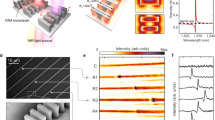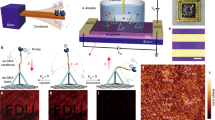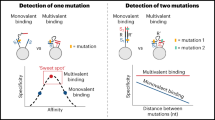Abstract
The ongoing discoveries of RNA modalities (for example, non-coding, micro and enhancer) have resulted in an increased desire for detecting, sequencing and identifying RNA segments for applications in food safety, water and environmental protection, plant and animal pathology, clinical diagnosis and research, and bio-security. Here, we demonstrate that single-molecule conductance techniques can be used to extract biologically relevant information from short RNA oligonucleotides, that these measurements are sensitive to attomolar target concentrations, that they are capable of being multiplexed, and that they can detect targets of interest in the presence of other, possibly interfering, RNA sequences. We also demonstrate that the charge transport properties of RNA:DNA hybrids are sensitive to single-nucleotide polymorphisms, thus enabling differentiation between specific serotypes of Escherichia coli. Using a combination of spectroscopic and computational approaches, we determine that the conductance sensitivity primarily arises from the effects that the mutations have on the conformational structure of the molecules, rather than from the direct chemical substitutions. We believe that this approach can be further developed to make an electrically based sensor for diagnostic purposes.
This is a preview of subscription content, access via your institution
Access options
Access Nature and 54 other Nature Portfolio journals
Get Nature+, our best-value online-access subscription
$29.99 / 30 days
cancel any time
Subscribe to this journal
Receive 12 print issues and online access
$259.00 per year
only $21.58 per issue
Buy this article
- Purchase on Springer Link
- Instant access to full article PDF
Prices may be subject to local taxes which are calculated during checkout




Similar content being viewed by others
Data availability
The data that support the findings of this study are available from the corresponding authors upon reasonable request.
References
Batt, C. A. Food pathogen detection. Science 316, 1579–1580 (2007).
Lazcka, O., Del Campo, F. J. & Muñoz, F. X. Pathogen detection: a perspective of traditional methods and biosensors. Biosens. Bioelectron. 22, 1205–1217 (2007).
Skottrup, P. D., Nicolaisen, M. & Justesen, A. F. Towards on-site pathogen detection using antibody-based sensors. Biosens. Bioelectron. 24, 339–348 (2008).
Kirkpatrick, B. C., Stenger, D. C., Morris, T. J. & Purcell, A. H. Cloning and detection of DNA from a nonculturable plant pathogenic mycoplasma-like organism. Science 238, 197–200 (1987).
Bartlett, J. M. S. & Stirling, D. in PCR Protocols 2nd edn (eds Bartlett, J. M. S. & Stirling, D) 3–6 (Humana,Totowa, 2003).
Xu, B. & Tao, N. J. Measurement of single-molecule resistance by repeated formation of molecular junctions. Science 301, 1221–1223 (2003).
Venkataraman, L., Klare, J. E., Nuckolls, C., Hybertsen, M. S. & Steigerwald, M. L. Dependence of single-molecule junction conductance on molecular conformation. Nature 442, 904–907 (2006).
Xiang, L. et al. Intermediate tunnelling-hopping regime in DNA charge transport. Nat. Chem. 7, 221–226 (2015).
Li, Y. et al. Comparing charge transport in oligonucleotides: RNA:DNA hybrids and DNA duplexes. J. Phys. Chem. Lett. 7, 1888–1894 (2016).
Gorodetsky, A. A., Buzzeo, M. C. & Barton, J. K. DNA-mediated electrochemistry. Bioconjug. Chem. 19, 2285–2296 (2008).
Kelley, S. O. & Barton, J. K. Electron transfer between bases in double helical DNA. Science 283, 375–381 (1999).
Lewis, F. D. & Wasielewski, M. R. Dynamics and efficiency of photoinduced charge transport in DNA: toward the elusive molecular wire. Pure Appl. Chem. 85, 1379–1387 (2013).
Sorgenfrei, S. et al. Label-free single-molecule detection of DNA-hybridization kinetics with a carbon nanotube field-effect transistor. Nat. Nanotech. 6, 126–132 (2011).
Michaels, P. et al. A robust DNA interface on a silicon electrode. Chem. Commun. 50, 7878–7880 (2014).
Slinker, J. D., Muren, N. B., Renfrew, S. E. & Barton, J. K. DNA charge transport over 34 nm. Nat. Chem. 3, 228–233 (2011).
Dulić, D. et al. Direct conductance measurements of short single DNA molecules in dry conditions. Nanotechnology. 20, 115502 (2009).
Zalinge, Hvan et al. Variable-temperature measurements of the single-molecule conductance of double-stranded DNA. Angew. Chemie 118, 5625–5628 (2006).
Guo, X., Gorodetsky, A. A., Hone, J., Barton, J. K. & Nuckolls, C. Conductivity of a single DNA duplex bridging a carbon nanotube gap. Nat. Nanotech. 3, 163–167 (2008).
Hihath, J., Xu, B., Zhang, P. & Tao, N. Study of single-nucleotide polymorphisms by means of electrical conductance measurements. Proc. Natl Acad. Sci. USA 102, 16979–16983 (2005).
Tenaillon, O., Skurnik, D., Picard, B. & Denamur, E. The population genetics of commensal Escherichia coli. Nat. Rev. Microbiol. 8, 207–217 (2010).
O’Brien, A. D. et al. Shiga-like toxin-converting phages from Escherichia coli strains that cause hemorrhagic colitis or infantile diarrhea. Science 226, 694–696 (1984).
Johannes, L. & Römer, W. Shiga toxins from cell biology to biomedical applications. Nat. Rev. Microbiol. 8, 105–116 (2010).
Rieger, R., Michaelis, A. & Green, M. M. Glossary of Genetics: Classical and Molecular (Springer, Berlin, 2012).
Nirenberg, M. & Leder, P. RNA codewords and protein synthesis. Science 145, 1399–1407 (1964).
Endres, R. G., Cox, D. L. & Singh, R. R. P. Colloquium: the quest for high-conductance DNA. Rev. Mod. Phys. 76, 195–214 (2004).
Maie, K., Miyagi, K., Takada, T., Nakamura, M. & Yamana, K. RNA-mediated electron transfer: double exponential distance dependence. J. Am. Chem. Soc. 131, 13188–13189 (2009).
O’Neill, M. A. & Barton, J. K. 2-Aminopurine: a probe of structural dynamics and charge transfer in DNA and DNA:RNA hybrids. J. Am. Chem. Soc. 124, 13053–13066 (2002).
Perna, N. T. et al. Genome sequence of enterohaemorrhagic Escherichia coli O157:H7. Nature 409, 529–533 (2001).
Altschul, S. F. et al. Gapped BLAST and PSI-BLAST: a new generation of protein database search programs. Nucleic Acids Res. 25, 3389–3402 (1997).
Prager, R., Fruth, A., Busch, U. & Tietze, E. Comparative analysis of virulence genes, genetic diversity, and phylogeny of Shiga toxin 2g and heat-stable enterotoxin STIa encoding Escherichia coli isolates from humans, animals, and environmental sources. Int. J. Med. Microbiol. 301, 181–191 (2011).
Touchon, M. et al. Organised genome dynamics in the Escherichia coli species results in highly diverse adaptive paths. PLoS Genet. 5, e1000344 (2009)..
Toranzo, A. E., Magarinos, B. & Romalde, J. L. A review of the main bacterial fish diseases in mariculture systems. Aquaculture 246, 37–61 (2005).
Seidel, C. A. M., Schulz, A. & Sauer, M. H. M. Nucleobase-specific quenching of fluorescent dyes. 1. Nucleobase one-electron redox potentials and their correlation with static and dynamic quenching efficiencies. J. Phys. Chem. 100, 5541–5553 (1996).
Yakovchuk, P., Protozanova, E. & Frank-Kamenetskii, M. D. Base-stacking and base-pairing contributions into thermal stability of the DNA double helix. Nucleic Acids Res. 34, 564–574 (2006).
Kypr, J., Kejnovská, I., Renčiuk, D. & Vorlíčková, M. Circular dichroism and conformational polymorphism of DNA. Nucleic Acids Res. 37, 1713–1725 (2009).
Lesnik, E. A. & Freier, S. M. Relative thermodynamic stability of DNA, RNA, and DNA:RNA hybrid duplexes: relationship with base composition and structure. Biochemistry 34, 10807–10815 (1995).
Vogtherr, M., Schübel, H. & Limmer, S. Structural and dynamic helix geometry alterations induced by mismatch base pairs in double-helical RNA. FEBS Lett. 429, 21–26 (1998).
Cooper, J. & Cass, T. Biosensors 2nd edn (Oxford Univ. Press, New York, 2004).
Kennard, O. Structural studies of DNA fragments: the G·T wobble base pair in A, B and Z DNA; the G·A base pair in B-DNA. J. Biomol. Struct. Dyn. 3, 205–226 (1985).
Berlin, Y. A. et al. Charge hopping in DNA. J. Am. Chem. Soc. 104, 260–268 (2001).
Giese, B., Amaudrut, J., Köhler, A., Spormann, M. & Wessely, S. Direct observation of hole transfer through DNA by hopping between adenine bases and by tunnelling. Nature 412, 318–320 (2001).
Artés, J. M., Li, Y., Qi, J., Anantram, M. P. & Hihath, J. Conformational gating of DNA conductance. Nat. Commun. 6, 8870 (2015).
Huang, Z., Xu, B., Chen, Y., Di Ventra, M. & Tao, N. Measurement of current-induced local heating in a single molecule junction. Nano Lett. 6, 1240–1244 (2006).
Case, D. A. et al. Computer Code AMBER 2016 (University of California, 2016); http://ambermd.org/.
Jorgensen, W. L., Chandrasekhar, J., Madura, J. D., Impey, R. W. & Klein, M. L. Comparison of simple potential functions for simulating liquid water. J. Chem. Phys. 79, 926–935 (1983).
Perez, A. et al. Refinement of the AMBER force field for nucleic acids: improving the description of alpha/gamma conformers. Biophys. J. 92, 3817–3829 (2007).
Zgarbova, M. et al. Refinement of the Cornell et al. nucleic acids force field based on reference quantum chemical calculations of glycosidic torsion profiles. J. Chem. Theory. Comput. 7, 2886–2902 (2011).
Ivani, I. et al. Parmbsc1: a refined force field for DNA simulations. Nat. Methods 13, 55–58 (2016).
Ryckaert, J. P., Ciccotti, G. & Beÿrendsen, H.J.C. Numerical integration of the cartesian equations of motion of a system with constraints: molecular dynamics of n-alkanes. J. Comput. Phys. 23, 327–341 (1977).
Darden, T., York, D. & Pedersen, L. Particle mesh Ewald: an N-log(N) method for Ewald sums in large systems. J. Chem. Phys. 98, 10089 (1998).
Stephens, P. J., Devlin, F. J., Chabalowski, C. F. & Frisch, M. J. Ab initio calculation of vibrational absorption and circular dichroism spectra using density functional force fields. J. Phys. Chem. 98, 11623–11627 (1994).
Petersson, G. A. & Al-Laham, M. A. A. complete basis set model chemistry. II Open-shell systems and the total energies of the first-row atoms.J. Chem. Phys. 94, 6081–6090 (1991).
Hehre, W. J., Ditchfield, R. & Pople, J. A. Self-consistent molecular orbital methods. XII. Further extensions of Gaussian-type basis sets for use in molecular orbital studies of organic molecules.J. Chem. Phys. 56, 2257 (1972).
Cau‰t, E., Valiev, M. & Weare, J. H. Vertical ionization potentials of nucleobases in a fully solvated DNA environment. J. Phys. Chem. B 114, 5886–5894 (2010).
Close, D. M. & Ohman, K. T. Ionization energies of the nucleotides. J. Phys. Chem. A 112, 11207–11212 (2008).
Russo, N., Toscano, M. & Grand, A. Theoretical determination of electron affinity and ionization potential of DNA and RNA bases. J. Comput. Chem. 21, 1243–1250 (2000).
CauëtE., Dehareng, D. & Liévin, J. Ab initio study of the ionization of the DNA bases: ionization potentials and excited states of the cations. J. Phys. Chem. A 110, 9200–9211 (2006).
Slavíček, P., Winter, B., Faubel, M., Bradforth, S. E. & Jungwirth, P. Ionization energies of aqueous nucleic acids: photoelectron spectroscopy of pyrimidine nucleosides and ab initio calculations. J. Am. Chem. Soc. 131, 6460–6467 (2009).
Frisch, M. J. et al. Computer code Gaussian 09, Revision D.1 (Gaussian, 2009)..
Rudberg, E. Difficulties in applying pure Kohn-Sham density functional theory electronic structure methods to protein molecules. J. Phys. Condens. Matter. 24, 072202 (2012).
Löwdin, P. O. On the nonorthogonality problem. Adv. Quantum Chem. 5, 185–199 (1970).
D'Amato, J. L. & Pastawski, H. M. Conductance of a disordered linear chain including inelastic scattering events. Phys. Rev. B 41, 7411 (1990).
Qi, J., Edirisinghe, N., Rabbani, M. G. & Anantram, M. P. Unified model for conductance through DNA with the Landauer–Büttiker formalism.Phys. Rev. B 87, 085404 (2013).
Acknowledgements
The authors thank M. Marco, W. Ju and D. Heeney for assistance with the BLASTn databases. This work is supported by the University of California, the Davis RISE program, the National Science Foundation (NSF, CBET-1605338) and the ONR (N00014-16-1-2658). M.P.A. acknowledges support from the NSF under grant nos. 102781 (CHE) and 1231927 (ECCS). E.E.O. acknowledges support from the Turkish Academy of Sciences under TUBA GEBIP grant.
Author information
Authors and Affiliations
Contributions
J.H., Y.L., E.E.O. and M.P.A. designed the research. Y.L., J.M.A., M.A. and J.H. performed and analysed CD and SMBJ experiments. B.D., S.G. and E.E.O. performed and analysed molecular dynamics simulations and provided a structural interpretation of the experimental data. B.D., E.E.O., H.M.M. and M.P.A. performed and analysed the DFT and transport calculations. Y.L. and J.H. wrote the paper with input from all authors. All authors contributed to revising the manuscript and agreed on its final content.
Corresponding authors
Ethics declarations
Competing interests
The authors declare no competing interests.
Additional information
Publisher’s note: Springer Nature remains neutral with regard to jurisdictional claims in published maps and institutional affiliations.
Supplementary information
Supplementary information
Supplementary figures 1–6; supplementary table 1
Rights and permissions
About this article
Cite this article
Li, Y., Artés, J.M., Demir, B. et al. Detection and identification of genetic material via single-molecule conductance. Nature Nanotech 13, 1167–1173 (2018). https://doi.org/10.1038/s41565-018-0285-x
Received:
Accepted:
Published:
Issue Date:
DOI: https://doi.org/10.1038/s41565-018-0285-x
This article is cited by
-
Electrical detection of RNA cancer biomarkers at the single-molecule level
Scientific Reports (2023)
-
Charge transport in individual short base stacked single-stranded RNA molecules
Scientific Reports (2023)
-
Advances in single-molecule junctions as tools for chemical and biochemical analysis
Nature Chemistry (2023)
-
A machine learning approach for accurate and real-time DNA sequence identification
BMC Genomics (2021)
-
Combined quantum tunnelling and dielectrophoretic trapping for molecular analysis at ultra-low analyte concentrations
Nature Communications (2021)



